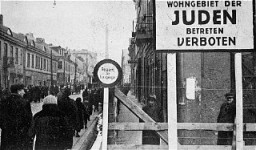You searched for: 网上电子游戏平台,网上电子游艺平台,【www.22kk66.com,复制打开网址】,电子博彩游戏大厅,十大电子游艺网站,正规博彩平台,澳门电子游艺娱乐城,电竞博彩平台,在线体育博彩网站,网上博彩平台大全,在线博彩平台排名,电竞博彩论坛,AG博彩平台推荐,,22kk66.com网址KAxBxKhfxfKfBEdBd
<< Previous | Displaying results 151-200 of 575 for "网上电子游戏平台,网上电子游艺平台,【www.22kk66.com,复制打开网址】,电子博彩游戏大厅,十大电子游艺网站,正规博彩平台,澳门电子游艺娱乐城,电竞博彩平台,在线体育博彩网站,网上博彩平台大全,在线博彩平台排名,电竞博彩论坛,AG博彩平台推荐,,22kk66.com网址KAxBxKhfxfKfBEdBd" | Next >>
-
Gisha Galina Bursztyn: Maps
Media EssayBorn to Jewish parents in Poland, Gisha Galina Bursztyn moved to the city of Warsaw after she married. On September 1, 1939, Germany invaded Poland. Warsaw fell four weeks later, and a ghetto was set up in November 1940. During a massive roundup i...
-
Receipt for items confiscated from Moshe Zupnik
DocumentSoviet authorities issued this receipt, in Russian, to Moshe Zupnik for the rubles they confiscated from him before he left the Soviet Union. Soviet authorities routinely confiscated most rubles and other valuables from Jewish refugees before they boarded steamers bound for Japan and left the Soviet Union. Vladivostok, Soviet Union, January 22, 1941. [From the USHMM special exhibition Flight and Rescue.]
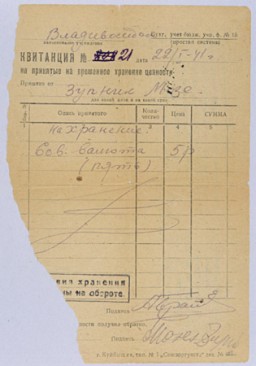
-
Pogrom in Lvov
FilmThe Soviet Union occupied Lvov in September 1939, according to secret provisions of the German-Soviet Pact. Germany invaded the Soviet Union on June 22, 1941, occupying Lvov within a week. The Germans claimed that the city's Jewish population had supported the Soviets. Ukrainian mobs went on a rampage against Jews. They stripped and beat Jewish women and men in the streets of Lvov. Ukrainian partisans supported by German authorities killed about 4,000 Jews in Lvov during this pogrom. US forces discovered…

-
A family of Macedonian Jews before deportation
PhotoA family of Macedonian Jews in the Tobacco Monopoly transit camp in Skopje before deportation. Skopje, Yugoslavia, March 1943. The Jews of Bulgarian-occupied Thrace and Macedonia were deported in March 1943. On March 11, 1943, over 7,000 Macedonian Jews from Skopje, Bitola, and Stip were rounded up and assembled at the Tobacco Monopoly in Skopje, whose several buildings had been hastily converted into a transit camp. The Macedonian Jews were kept there between eleven and eighteen days,…
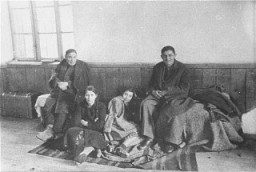
-
Deportation of Jews from Skopje
PhotoDeportation of Jews from Skopje, Yugoslavia, March 1943. The Jews of Bulgarian-occupied Thrace and Macedonia were deported in March 1943. On March 11, 1943, over 7,000 Macedonian Jews from Skopje, Bitola, and Stip were rounded up and assembled at the Tobacco Monopoly in Skopje, whose several buildings had been hastily converted into a transit camp. The Macedonian Jews were kept there between eleven and eighteen days, before being deported by train in three transports between March 22 and 29, to Treblinka.
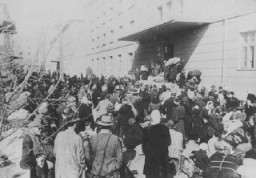
-
Nazi Persecution of Soviet Prisoners of War
ArticleNazi Germany waged a war of annihilation against the Soviet Union. This included brutally treating Soviet POWs and murdering them on a mass scale. Learn more.
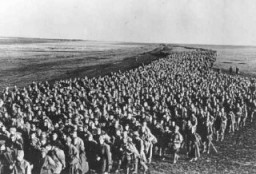
-
German Invasion of Western Europe, May 1940
ArticleGerman troops overran Belgium, the Netherlands, Luxembourg, and France in six weeks starting in May 1940. Anti-Jewish measures soon followed in occupied western Europe.
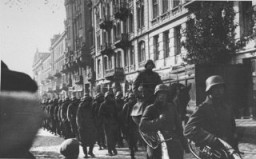
-
Amsterdam
ArticleLearn about Amsterdam during World War II and the Holocaust, including deportations of Jews to concentration camps and killing centers.
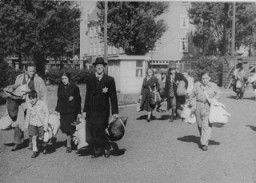
-
Danzig
ArticleHitler was determined to overturn the military and territorial provisions of the Versailles treaty, among it was much resented loss of the city of Danzig after WWI.
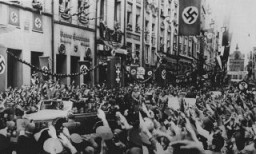
-
Norway
ArticleGermany invaded Norway on April 9, 1940. Read more about this invasion, the collaborator Vidkun Quisling, and the tragic fate of Norway’s Jews.
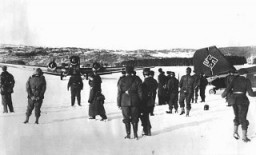
-
Sachsenhausen: Key Dates
ArticleKey dates in the history of the Sachsenhausen camp in the Nazi camp system, from its establishment in 1936 to the postwar trial of camp staff in 1947.
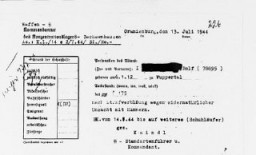
-
Subsequent Nuremberg Proceedings, Case #5: The Flick Case
ArticleThe Flick Case was Case #5 of 12 Subsequent Nuremberg Proceedings against leading German industrialists, military figures, SS perpetrators, and others.
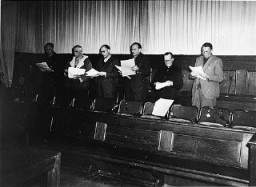
-
Sam Gruber (Jewish Partisan Educational Foundation biography)
ArticleRead the Jewish Partisan Educational Foundation's short biography of Sam Gruber.
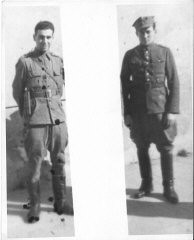
-
United States Immigration and Refugee Law, 1921–1980
ArticleUS immigration and refugee laws and policies evolved in response to World War I, the 1918 influenza pandemic, and World War II and the Holocaust. Learn more.
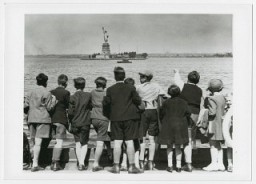
-
1941: Key Dates
ArticleExplore a timeline of key events during 1941 in the history of Nazi Germany, World War II, and the Holocaust.
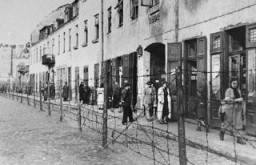
-
Chuna Grynbaum: Maps
Media EssayChuna Grynbaum was born to Jewish parents in Starachowice, Poland in 1928. When he was 13 years old, Chuna was sent to forced labor at a munitions factory. In 1943, he attempted to escape with his sister, Faiga. Faiga...
-
Aron and Lisa Derman: Oral History Excerpts
Media EssayIn 1942, Aron Derman and Lisa Nussbaum escaped deportation from the Grodno ghetto with the help of Tadek Soroka, a non-Jewish Pole. Aron and Lisa—aged 19 and 15—joined the armed Jewish resistance. As partisans, they f...
-
Einsatzgruppen massacres in eastern Europe (enlargement)
MapEinsatzgruppen were German special duty units, composed primarily of SS and police personnel, assigned to kill Jews as part of the Nazi program to kill the Jews of Europe. During the invasion of the Soviet Union in June 1941, the mobile killing squads followed the German army as it advanced deep into Soviet territory, and carried out mass-murder operations. Wherever the Einsatzgruppen went they shot Jewish men, women, and children, without regard for age or gender. Einsatzgruppen killed more than a…

-
Jewish parachutist Hannah Szenes with her brother
PhotoJewish parachutist Hannah Szenes with her brother, before leaving for a rescue mission. Palestine, March 1944. Between 1943 and 1945, a group of Jewish men and women from Palestine who had volunteered to join the British army parachuted into German-occupied Europe. Their mission was to organize resistance to the Germans and aid in the rescue of Allied personnel. Hannah Szenes was among these volunteers. Szenes was captured in German-occupied Hungary and executed in Budapest on November 7,…

-
Norman Salsitz's wife and daughter
PhotoNorman's daughter, Esther, at three weeks of age, with her mother, Amalie. September 1956. With the end of World War II and collapse of the Nazi regime, survivors of the Holocaust faced the daunting task of rebuilding their lives. With little in the way of financial resources and few, if any, surviving family members, most eventually emigrated from Europe to start their lives again. Between 1945 and 1952, more than 80,000 Holocaust survivors immigrated to the United States. Norman was one of them.
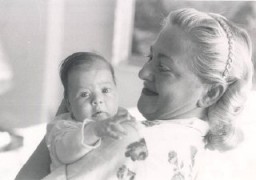
-
Theresienstadt: Other Prisoners
ArticleLearn more about the fate of Jewish prisoners that were deported to Theresienstadt from places other than the Greater German Reich or the Protectorate.
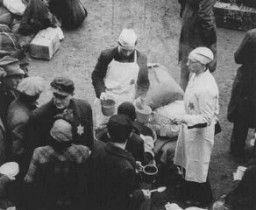
-
Salonika
ArticleSalonika, Greece was invaded and occupied by the Nazis in 1941. Learn more about the fate of the Jews in Salonika during World War II.
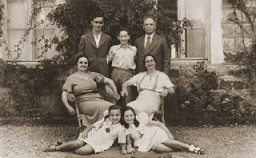
-
Karl Marx
ArticleKarl Marx was a political theorist and philosopher. He published “The Communist Manifesto” with Friedrich Engels. His works were burned in Nazi Germany in 1933.
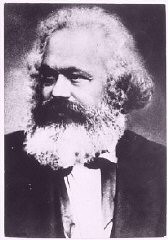
-
Meir Porges
ArticleRead the Jewish Partisan Educational Foundation's short biography of Meir Porges.
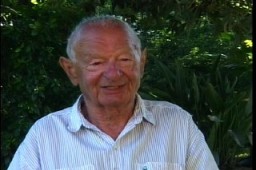
-
Alexander White
ArticleRead the Jewish Partisan Educational Foundation's short biography of Alexander White.
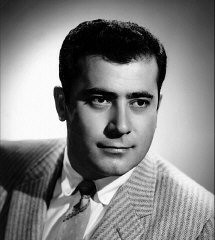
-
Emil Ludwig
ArticleEmil Ludwig was a liberal journalist and popular biographer whose works were burned under the Nazi regime in 1933. Learn more.
-
Sara Fortis
ArticleRead the Jewish Partisan Educational Foundation's short biography of Sara Fortis.
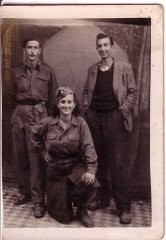
-
Euthanasia Program and Aktion T4
ArticleThe Nazi Euthanasia Program, codenamed Aktion "T4," was the systematic murder of institutionalized people with disabilities. Read about Nazi “euthanasia.”
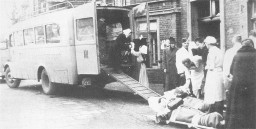
-
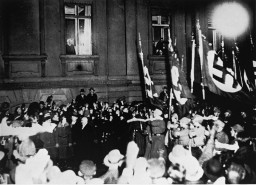
-
World War II in Europe
ArticleGermany started World War II in Europe on September 1, 1939, by invading Poland. War would continue until 1945. Learn more about WWII and genocide in Europe.
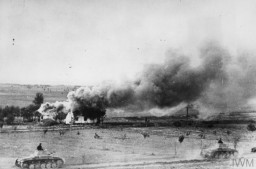
-
Polish Jews in Lithuania: Escape to Japan
ArticleAfter 1940, Polish refugees were pressured to leave Lithuania. Learn more about the diplomats that assisted them and their journey to Japan.
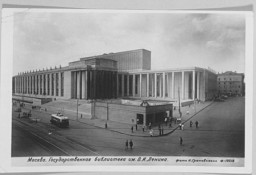
-
Genocide Timeline
ArticleKey dates in the use of the term genocide as part of the political, legal, and ethical vocabulary of responding to widespread threats of violence against groups.

-
Subsequent Nuremberg Proceedings, Case #9, The Einsatzgruppen Case
ArticleThe Einsatzgruppen Case was Case #9 of 12 Subsequent Nuremberg Proceedings against leading German industrialists, military figures, SS perpetrators, and others.
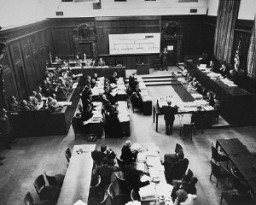
-
Drancy
ArticleThe Germans established an internment camp at Drancy in August 1941. The following summer, Drancy became the main transit camp for deportations of Jews from France.
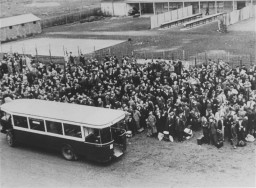
-
Soviet Secret Police massacre in Lvov
FilmThe Soviet Union occupied Lvov in September 1939, according to secret provisions of the German-Soviet Pact. Germany invaded the Soviet Union on June 22, 1941. After a week of bitter fighting, German forces occupied Lvov. They discovered that the Soviet Secret Police had massacred thousands of prisoners, mostly Ukrainian nationalists, before fleeing from the city. This footage shows the removal of the bodies of some of those massacred. The Germans claimed that the city's Jewish population had supported the…
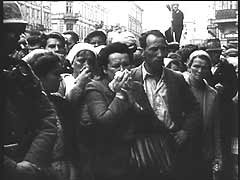
-
Jews from Macedonia before deportation
PhotoJews from Bulgarian-occupied Macedonia who were rounded up and assembled at the Tobacco Monopoly transit camp in Skopje before deportation to the Treblinka killing center. Skopje, Yugoslavia, March 1943. The Jews of Bulgarian-occupied Thrace and Macedonia were deported in March 1943. On March 11, 1943, over 7,000 Macedonian Jews from Skopje, Bitola, and Stip were rounded up and assembled at the Tobacco Monopoly in Skopje, whose several buildings had been hastily converted into a transit camp. The…
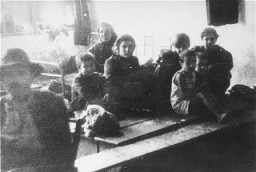
-
Macedonian Jews leave the Tobacco Monopoly transit camp in Skopje for the deportation trains
PhotoMacedonian Jews leave the Tobacco Monopoly transit camp in Skopje for the deportation trains. Skopje, Yugoslavia, March 1943. The Jews of Bulgarian-occupied Thrace and Macedonia were deported in March 1943. On March 11, 1943, over 7,000 Macedonian Jews from Skopje, Bitola, and Stip were rounded up and assembled at the Tobacco Monopoly in Skopje, whose several buildings had been hastily converted into a transit camp. The Macedonian Jews were kept there between eleven and eighteen days, before being…
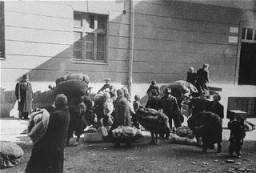
-
Presenting the prosecution's case at the International Military Tribunal
PhotoUS Major Frank B. Wallis (standing center), a member of the trial legal staff, presents the prosecution's case to the International Military Tribunal at Nuremberg. A chart (top left) shows where the defendants (bottom left) fit into the organizational scheme of the Nazi Party. At right are lawyers for the four prosecuting countries. Nuremberg, Germany, November 22, 1945. The trials of leading German officials before the International Military Tribunal are the best known of the postwar war crimes trials.…
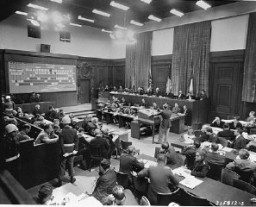
-
Jews from Macedonia before deportation to the Treblinka killing center
PhotoJews from Macedonia who were rounded up and assembled in the Tobacco Monopoly transit camp before deportation to the Treblinka killing center. Skopje, Yugoslavia, March 1943. The Jews of Bulgarian-occupied Thrace and Macedonia were deported in March 1943. On March 11, 1943, over 7,000 Macedonian Jews from Skopje, Bitola, and Stip were rounded up and assembled at the Tobacco Monopoly in Skopje, whose several buildings had been hastily converted into a transit camp. The Macedonian Jews were kept there…
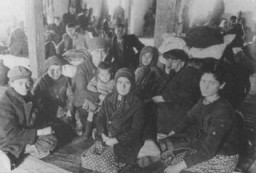
-
Jews outside the Monopol tobacco factory transit camp
PhotoJews outside the Monopol tobacco factory, used as a transit camp by Bulgarian authorities during deportations from Macedonia to the Treblinka killing center in German-occupied Poland. Skopje, Yugoslavia, March 1943. The Jews of Bulgarian-occupied Thrace and Macedonia were deported in March 1943. On March 11, 1943, over 7,000 Macedonian Jews from Skopje, Bitola, and Stip were rounded up and assembled at the Tobacco Monopoly in Skopje, whose several buildings had been hastily converted into a transit camp.…
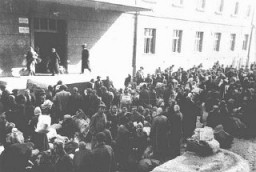
-
Jews prepare soup outside the Monopol tobacco factory transit camp
PhotoJews prepare soup outside the Monopol tobacco factory, used as a transit camp by Bulgarian authorities during deportations of Jews from Macedonia. Skopje, Yugoslavia, March 1943. The Jews of Bulgarian-occupied Thrace and Macedonia were deported in March 1943. On March 11, 1943, over 7,000 Macedonian Jews from Skopje, Bitola, and Stip were rounded up and assembled at the Tobacco Monopoly in Skopje, whose several buildings had been hastily converted into a transit camp. The Macedonian Jews were kept there…
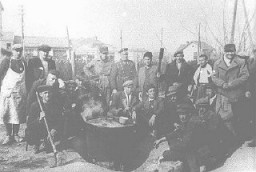
-
Macedonian Jews prepare to board a deportation train in Skopje
PhotoMacedonian Jews prepare to board a deportation train in Skopje. Skopje, Yugoslavia, March 1943. The Jews of Bulgarian-occupied Thrace and Macedonia were deported in March 1943. On March 11, 1943, over 7,000 Macedonian Jews from Skopje, Bitola, and Stip were rounded up and assembled at the Tobacco Monopoly in Skopje, whose several buildings had been hastily converted into a transit camp. The Macedonian Jews were kept there between eleven and eighteen days, before being deported by train in three transports…
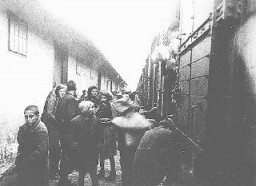
-
Debate within the Lokacze Ghetto
ArticleDifficult debates took place within ghettos about whether and how to resist under the most adverse conditions. Read a rare account from the Lokacze ghetto.
-
Western Desert Campaign: Egypt and Libya
ArticleLearn more about the Western Desert campaign during World War II in Egypt and Libya between 1940-1943.

-
Trawniki: Key Dates
ArticleExplore a timeline of key events in the history of the Trawniki in German-occupied Poland.
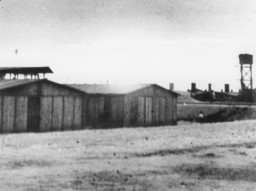
-
Reinhard Heydrich: Key Dates
ArticleKey dates in the life of Reinhard Heydrich, chief of the Reich Security Main Office, the SS and police agency most directly concerned with implementing Final Solution.
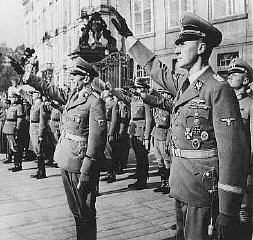
-
Heinrich Himmler: Key Dates
ArticleHeinrich Himmler was the leader of the dreaded SS of the Nazi Party from 1929 until 1945. Learn more about key dates in the life of Heinrich Himmler.
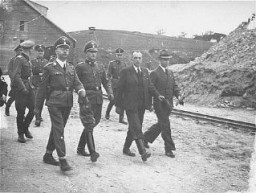
-
At the Killing Centers
ArticleThe Nazis established killing centers in German-occupied Europe to mass murder Jews. Learn more about what happened to Jewish people at these killing centers.
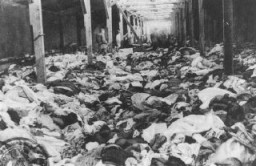
-
1940: Key Dates
ArticleExplore a timeline of key events during 1940 in the history of Nazi Germany, World War II, and the Holocaust.
